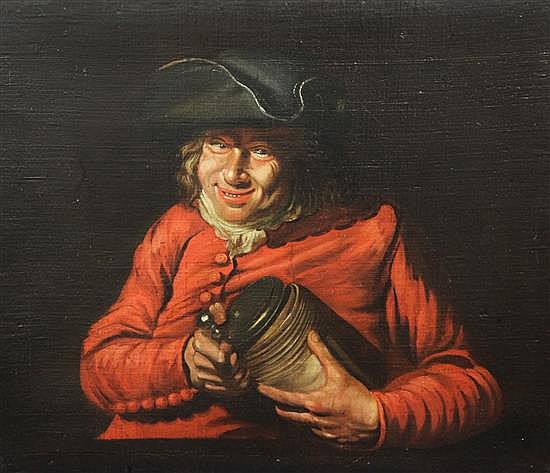
Doccia steins – Porcelain steins made in Doccia, Italy by the Ginori family in the very early 1800’s. When they surface (not often) they are erroneously called “Capo-di-Monti” (see photos in “C” ) or “Capo-di-monti style” by the uneducated, or those who refuse to change, as they don’t even resemble them in decor or size or coloration. Shown: Doccia porcelain relief copy of the famous Dresden’s Green Vaults Ivory stein (hence its oval body shape.) [FWTD] For more info on this stein, see: http://www.steveonsteins.com/silver
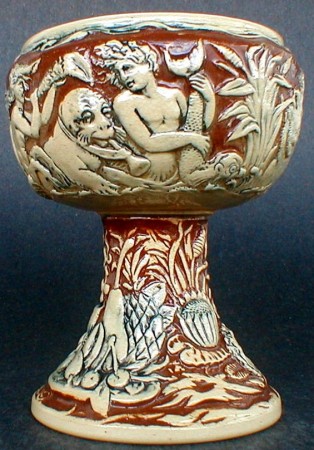
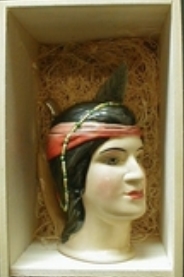
Domex – Makers of new steins in the late 1900’s. Shown : A new character stein made by Domex, in their shipping box (S.C.). See: http://www.steinmarks.co.uk/pages/pv.asp?p=stein1
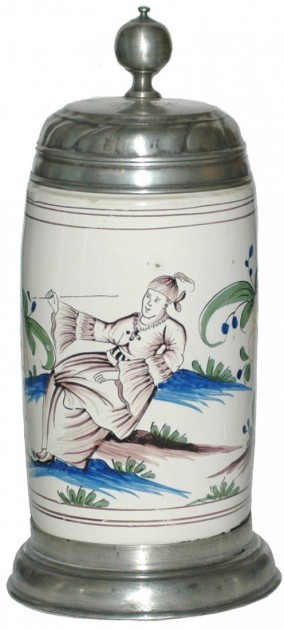
Dorotheenthal 1707-1806 – City or town of major fayence stein production. For more info, see: http://www.thepatriotexchange.com/pss/hisfai.htm
. 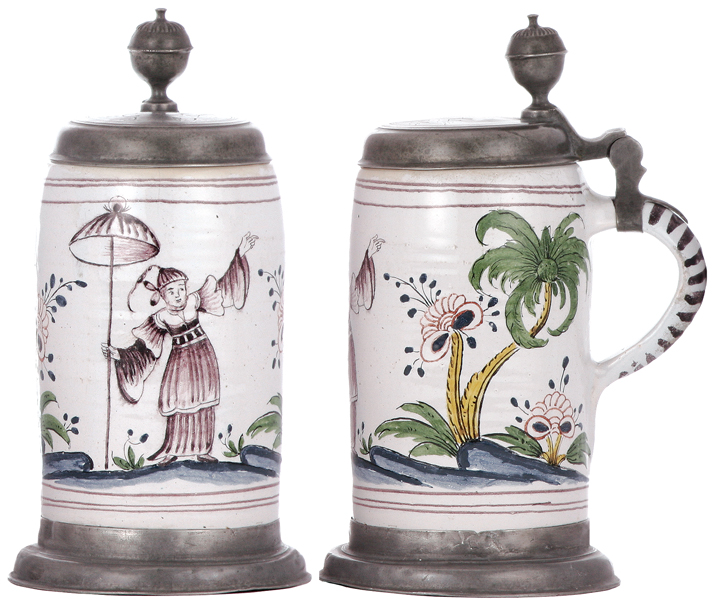 ]
]
[tsaco]
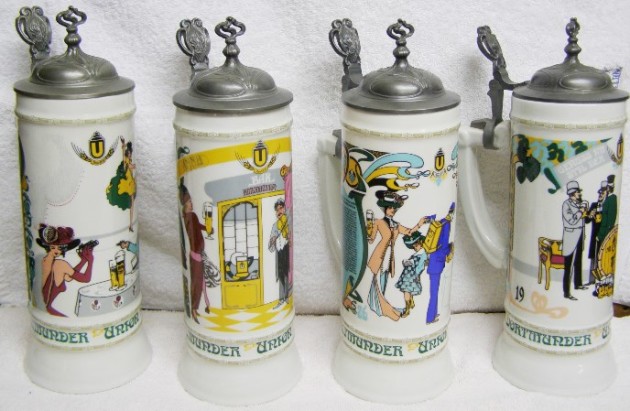
Dortmunder Union Beer – Shown ▲ a series of anniversary steins. New, but decorative.
.
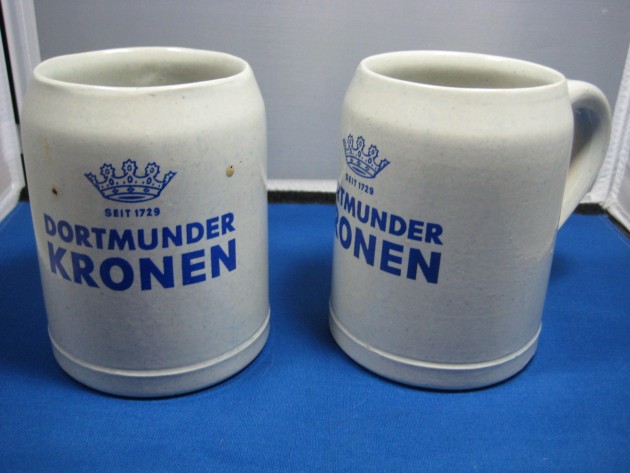
Dorfner and Co. (“D&C”) – Above ▲is an beautiful beer stein created by Dorfner and Co. The company was established in 1829 in Hirschau, Bavaria and existed until 1890. It produced high quality beer steins that are actually quite scarce.
Info ▼ ▼on Dorfner’s firm is from Chris Wheeler’s “Stein Marks”
http://www.steinmarks.co.uk/pages/pv.asp?p=stein1
Founded in April 1826 by the partnership of, Karl Martin Dorfner, Joseph Konstantin Dorfner, Heinrich Waffler (I) & Johann Dietrich Mayer. Within two years, they had a total of 45 employees, some of which were involved in kaolin mining and preparation, but included 26 potters and one or two decorators. By 1833 Heinrich Waffler had left and in 1849 Johann Mayer and his family emigrated to America. By 1870 the employee count had risen to 120. By 1883 and until 1890 the partnership was made up of Josef, Michael and Ernst Dorfner, with Josef as Managing Partner. However in 1890 the partnership fragmented, due to constant family disputes, although production continued. Some shares in the company were sold in 1894. Ernst Dorfner then started his own company, whilst the sons of Josef Dorfner, Hermann & Florian, founded the
Gebrüder Dorfner, on the 16th January 1895.
Reference: Kaolin Mines
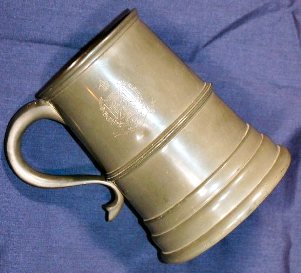
Double “C” [or] Double-scroll handle — A sinuous line of S-shape, or composed of reverse curves, used frequently in the design of handles, mostly English pewter and sometimes silver. Shown above ▲: A British pewter mug / cann named to the 62ND Regiment (Inf.) Unknown exact age, Circa 1870 I believe. It has 3 dice in the bottom between two glass bottoms. [FWTD] .
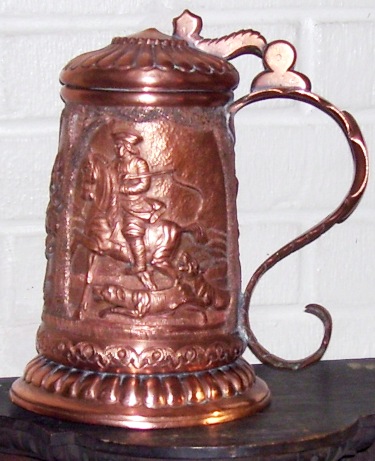
Another example where the bottom “C” is more pronounced. Austrian. One liter, heavy copper. Ca. 1850. [FWTD]
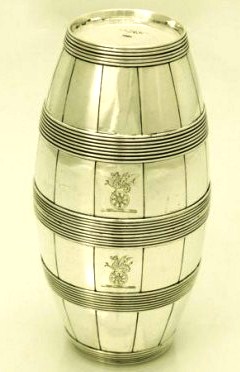
Double cup or beaker: Two identical beakers, one of which has a rim that fits inside the other. Usually made in metal and popular from the 1600’s throughout Europe.
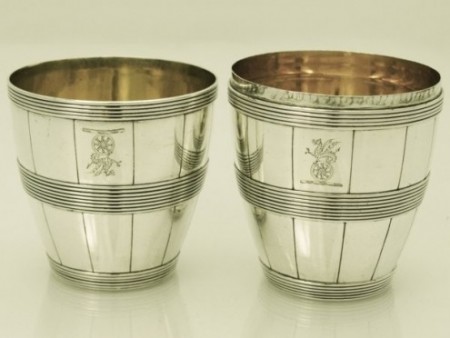
One beaker is slightly larger because of the added rim. Lots of the antique examples are now missing one of the cups – such as I assume the one shown just below ▼ had happen.
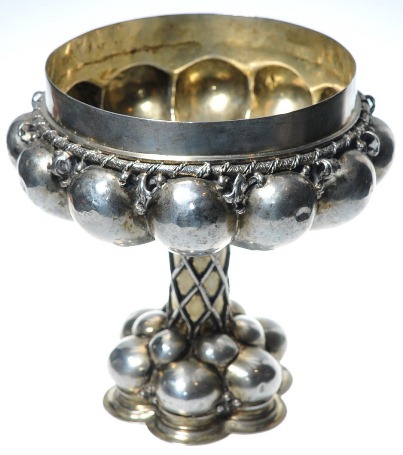
Hanau copy of Renaissance silver double cup = one half of one. Ca. 1880. Double firing — the process of firing biscuit (unglazed) pottery, then glazing, decorating and re-firing.
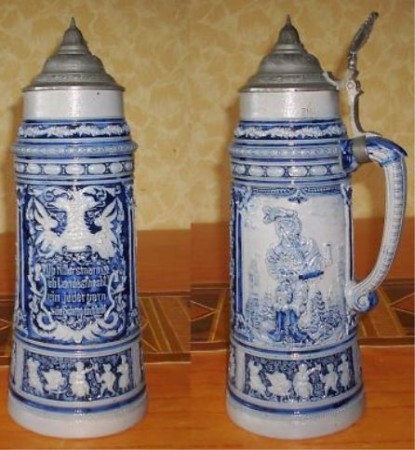
Double headed eagle – See “Eagle, double headed.” or “Adler.”
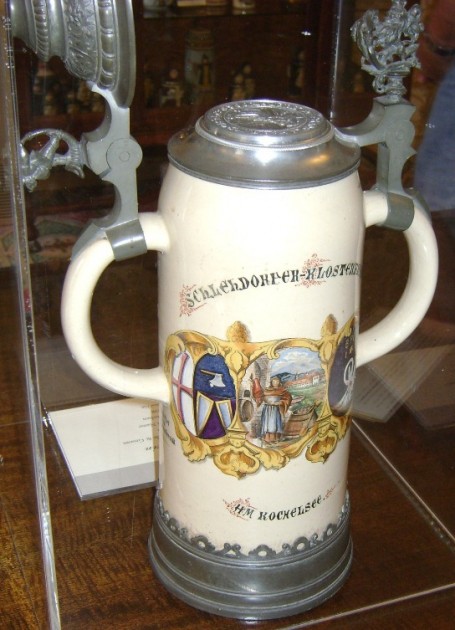
“Double Lidded Steins” – Self explanatory. Steins which have a full lid on each handle and are made to sit on top of each other.These are not he same as “Split Lidded Steins “(see in this Compendium.) As shown ▲: Brewery steins are the ones found most often with this feature. [Comps of Feltner Community Foundation Museum, Winchester Va.)
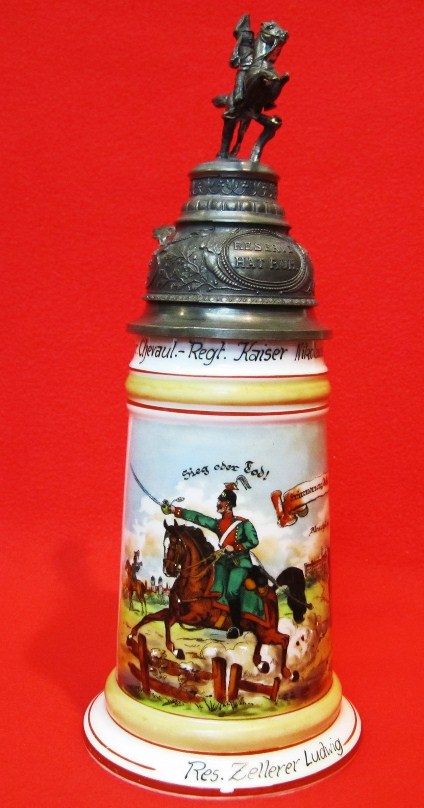
Double tiered lids – Lids on reservist and reservist reproductions that have two tiers before coming the the finial’s platform. Also see: http://www.steveonsteins.com/reservists-regimental-reproductions-1-2
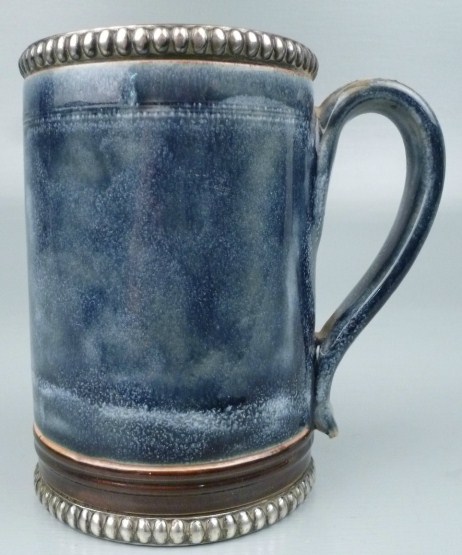
Doulton Lambeth stoneware mug with Sterling Silver mounts. .
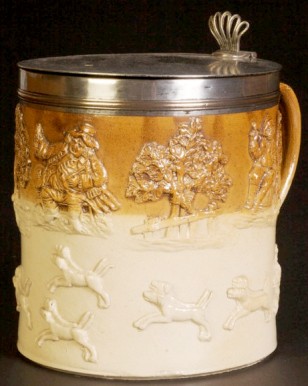
Doulton, Lambeth – Maker of English stoneware mugs and steins amongst other items. Shown: Just above and below: A quart, Sterling silver mounted stein. Circa 1869. Sometimes called “Harvest” steins and mugs.
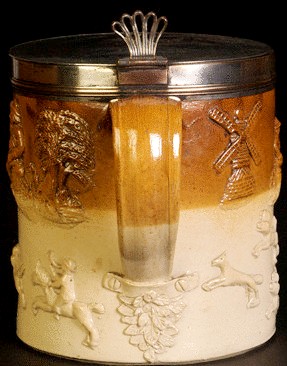
Handle detail – “Lambeth” being the place name in London, just South of the old city. The firm was later called Royal Doulton,
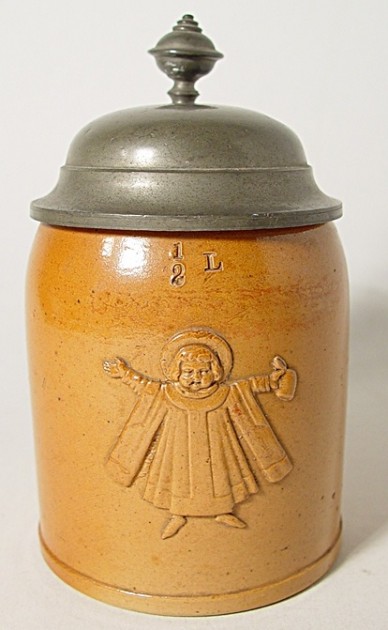
.
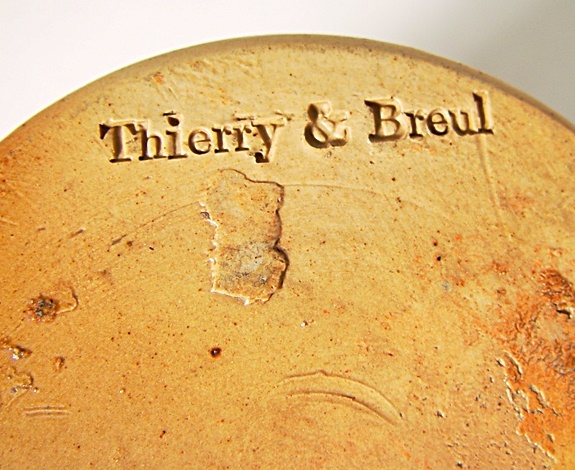
Above: A half liter stein made for the Munich market by Doulton and distributed by Thierry & Breul. For this firm’s history, see: http://www.steinmarks.co.uk/pages/pv.asp?p=stein451
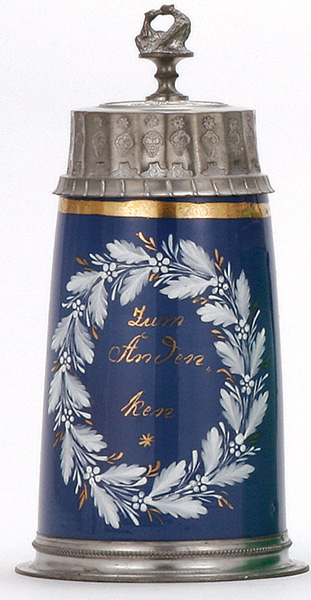
Doves kissing – Shown ▲: 5L, blue milk glass, enameled, “Zum Andenken,” (In Memory), Ca. 1840, with the thumblift of the two “doves kissing” which always indicated love / great admiration. Doves are seen on these thumblifts and on early enameled clear glass steins usually over a painted heart and infrequently on engraved clear glass stein from the early 1800’s, as shown below ▼. .
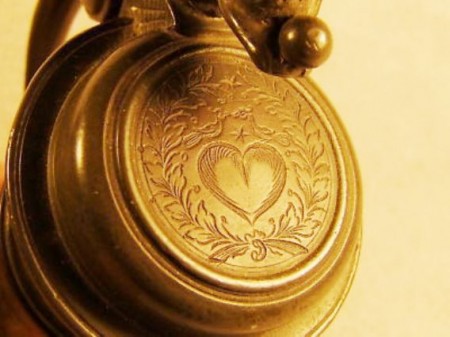
Not a good photo ▲, but this 1600’s roerken’s pewter lid has a brass insert with the German “LOVE” symbol / icon of the two doves over a heart engraved on it. [FWTD] Doves and Heart. – See: “Hearts and Doves,” in this site’s Compendium.
.
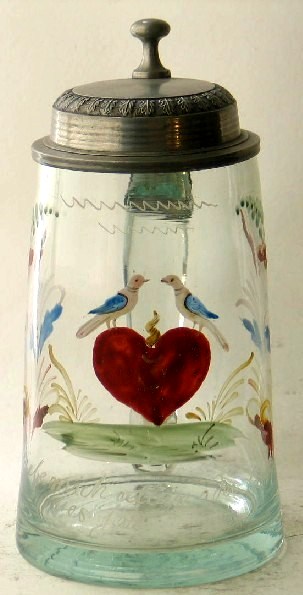
▲ Bohemian, blown clear (greenish tint) glass stein. Ca. 1830.
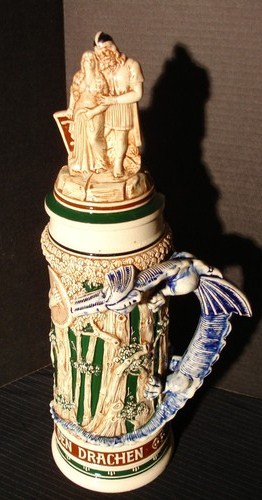
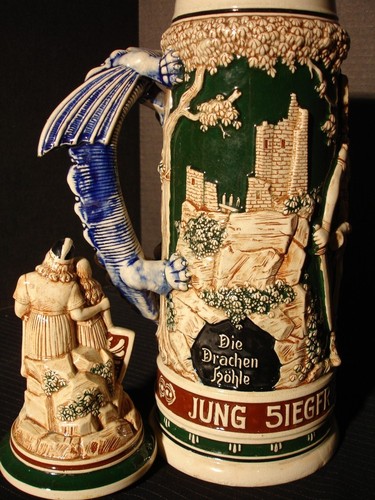
Dragonfels / Drachenfels — The castle where Siefried defeats the dragon. “Siegfried” the opera, is the third of the four operas that constitute Der Ring des Nibelungen (The Ring of the Nibelung), by Richard Wagner. Now-a- days at Dragonfels, Königswinter, just outside of Bonn, are the ruins of the castle where legend has it Siegfried slew the dragon (and got the ring!). Shown: A 2 liter pottery relief stein, set on lid, shown scenes from the legend / opera. A nice dislay piece but with that handle, not very practical.
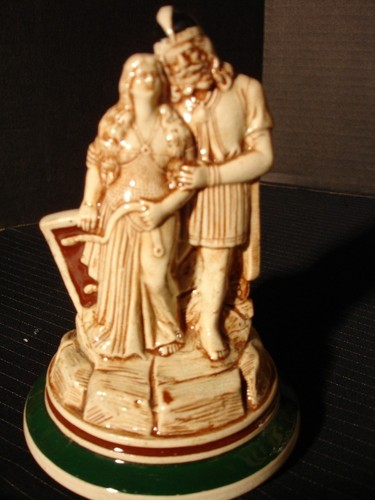
Siegfried and Brünnhilde.
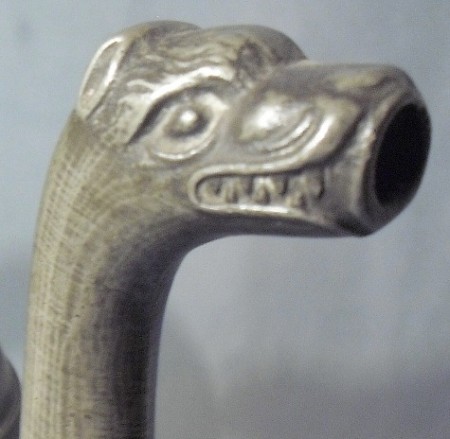
Dragon spout – Most often found on pewter wine servers from the 1700’s. Later on some of the early coffee pots. .
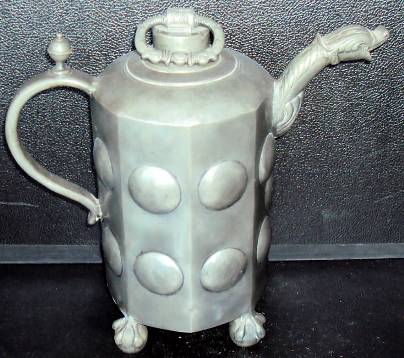
Dragon spout on a 12 inch tall Swiss “Schraubkanne”, dated 1797. {FWTD}
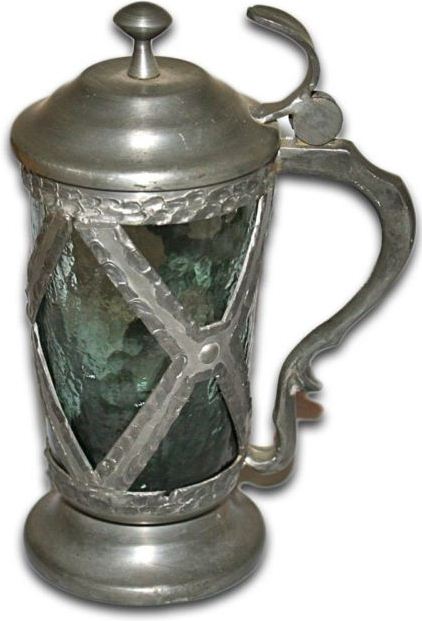
Drangsgaard – A small firm in Norway that made modern hand crafted pewter items such as this tankard with a glass insert.
Dresden – A very old city in Saxony with numerous porcelain (quite expensive, even then) stein makers. Also a major area known earlier for the production of fayence beer steins. Shown: Perhaps one of the moderately priced (at that time) porcelain half liter relief steins. Dresden, Circa 1880.[FWTD] Dresden 1708-1784 – City or town of major fayence stein production. For more info, see: http://www.thepatriotexchange.com/pss/hisfai.htm D.R.G.M. – Deutsches Reich Gebrauchsmuster. = German Reich Registered Design – Pre 1949.
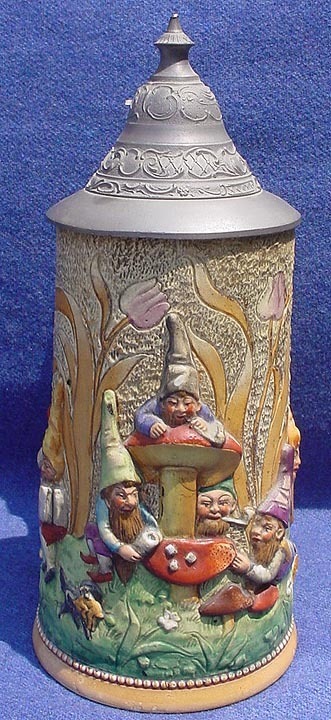
D.R.G.M. 154927 [marked steins] – The copyright number assigned to A. Deisinger. [See above ▲] Duetsches Reich Gebrauchmuster” is a patent claim, protecting the manner in which Diesinger decorated his pottery pieces. Shown above ▲; A typical .5 liter, gnome scene, pottery relief stein, by Deisinger, with button row at bottom and serrated background. He was also responsible for DRGM 250635, which was anew method of attaching the lid to the handle See: http://www.steinmarks.co.uk/pages/pv.asp?p=stein1 Dreihausen – Pottery center in old Hesse. Produced (ugly?) brown glazed plain wares. John Stuart used to call that color “Baby Shit Brown.” Lots of other people like it – I do not! Drillingskrug – German for a “Fuddling Cup.” See: Fuddling cups / jugs in this site’s Compendium.
![SOS - 14 INCH TALL COPPER BOOT - ASKING $14XX - [A]](http://www.steveonsteins.com/wp-content/uploads/2013/06/SOS-14-INCH-TALL-COPPER-BOOT-ASKING-14XX-A.jpg)
Drinking boot = see ” Beer boot” Shown: a 10 in tall German made copper boot for sale at over $1100,00 in 2014. I like copper vessels but not that much !!
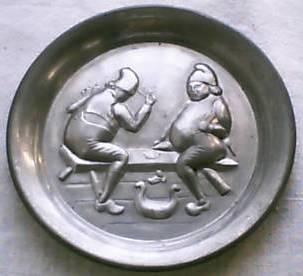
Drinking bowl – handled (Also called “beer bowls.” ) – A favorite vessel in Scandinavia and the Baltic States and Russia, the older ones made of wood and mostly held by two hands, and communal. Shown above ▲: A couple of Gambrinus Stein Club members playing cards and sharing a Swedish beer bowl! Also see: Wassail Bowl (English ), Mazer (Scottish mostly) ) and Kovsh and Bratina (Russian) .
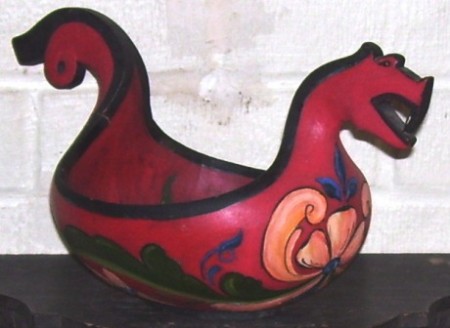
Shown above ▲: A “kasa.” Carved and dated 1902 with a bit of touch up on the paint. [FWTD]
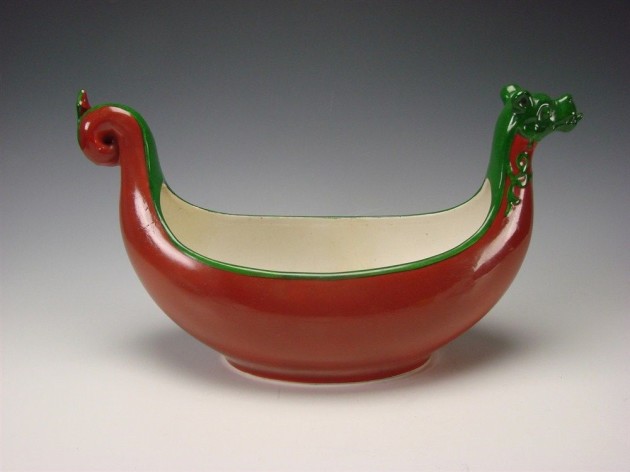
A newer Version made by Rorstrand Porcelain in Sweden, For other Rorstrand drinking vessels see: http://www.steveonsteins.com/rorstrand-pottery-beer-steins-servers-beakers-etc-awpd
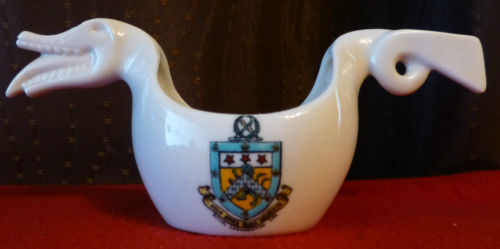
Miniature porcelain Scandinavian souvenir drinking bowl, with a city’s arms. produced by Gross. a Scandinavian Kasa, chipped carved Ca. 1940.
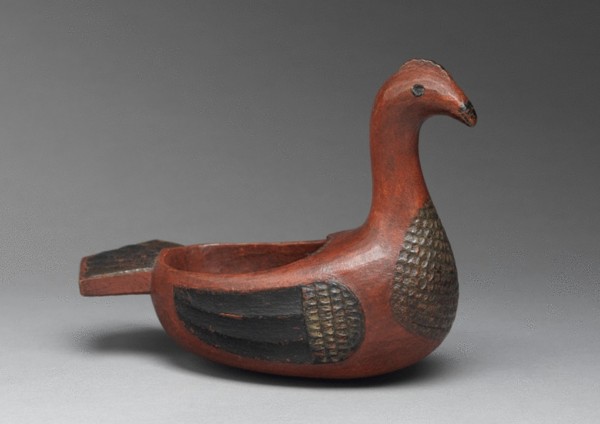
Above ▲:A carved wooden Drinking bowl from Norway, called an “Ale Hen” by a London antiques dealer. I have never seen that term used before but I’ve only been collecting for 43 years!!
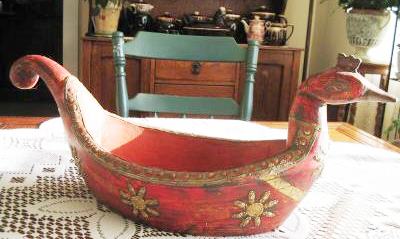
If the above is a true term in England then I guess this would be an “Ale Duck ! ” Russian or Baltic states C. 1900
Drinking bowl – Not handled or un-handled (which could imply the handles were broken off, which these weren’t. ) (Also called “beer bowls.” ) Along with those above were also favored vessels in Scandinavia and the Baltic States.
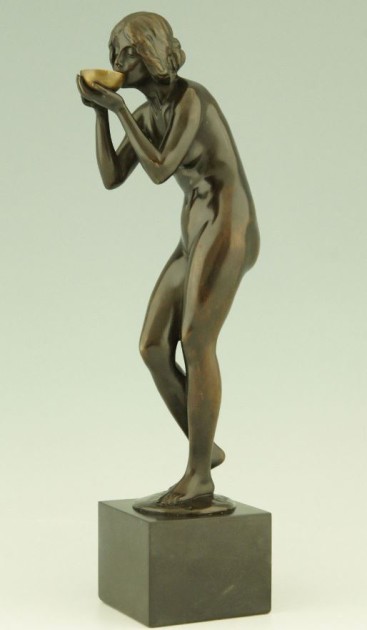
Of course drinking from just plain bowls goes way, way back into Greek and Roman times.and not to long ago the English were still drinking their tea from bowls.▲

Two Scandinavian turned softwood beer bowls, 19th century, withinscription to the outer rim, ‘Let this cup be passed round, and when emptied filled again!’
.

A Scandinavian turned softwood beer bowl, 1879, with all over painted decoration, an inscription to the rim and dated 1879, incised ‘E.H.’ to the underside, 20cm
Drinking bowl – un – handled (Also called “beer bowls.” )

A larger and personalized carved and painted bowl for other examples of these see: http://www.steveonsteins.com/wooden-steins
![RDRINKING BOWL - A Scandinavian turned softwood beer bowl, 1833, with all over painted decoration, an inscription to the rim and dated 1833, 17cm diameter [2]](http://www.steveonsteins.com/wp-content/uploads/2013/06/RDRINKING-BOWL-A-Scandinavian-turned-softwood-beer-bowl-1833-with-all-over-painted-decoration-an-inscription-to-the-rim-and-dated-1833-17cm-diameter-2.jpg)
Inside view of another unhandled Scandinavian drinking bowl – seems like a shame to use it.
D.B.P.= Deutsches Bundespatent = German Federal Patent- Post 1949.
D.R.P. – Deutsches Reichpatent = German Federal Patent – Pre 1949. Drum — The section of the vessel between the lid and the base; the main body of a drinking vessel.
Drinking horn –
SEE: http://www.steveonsteins.com/in-the-near-future-2
[and] http://www.steveonsteins.com/in-the-near-future-2-1-4
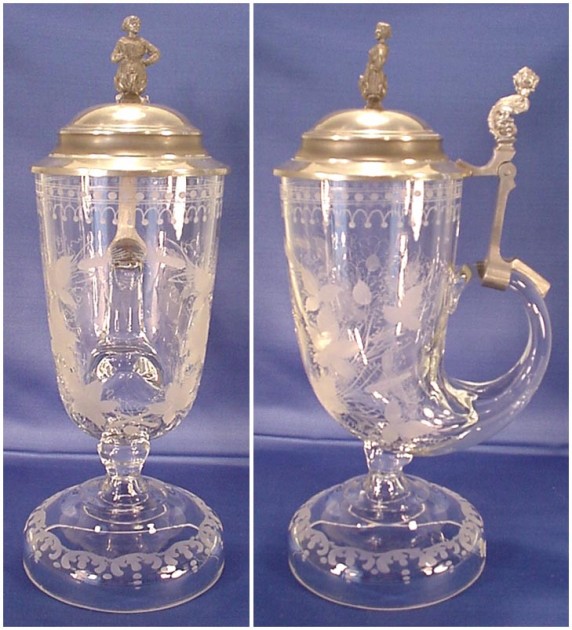
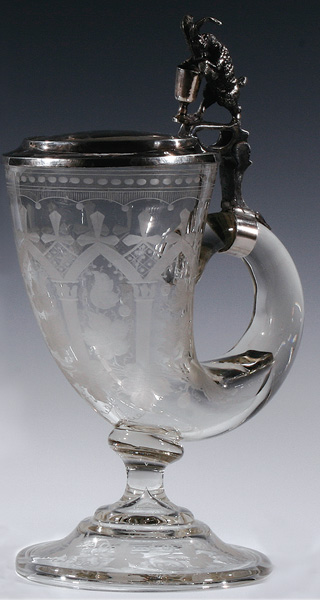
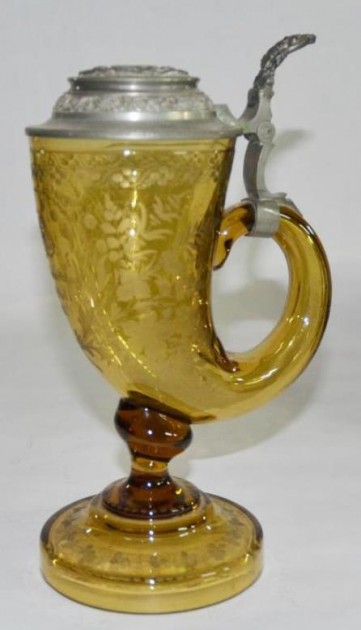
Another great piece by WMF who had their own glasshutte, so this stein and the colorless glass above more than likely would have been engraved [not etched ] by them also.
BELOW NEWEER GLASS HORN STEINS IN THE OLD TRADITION.
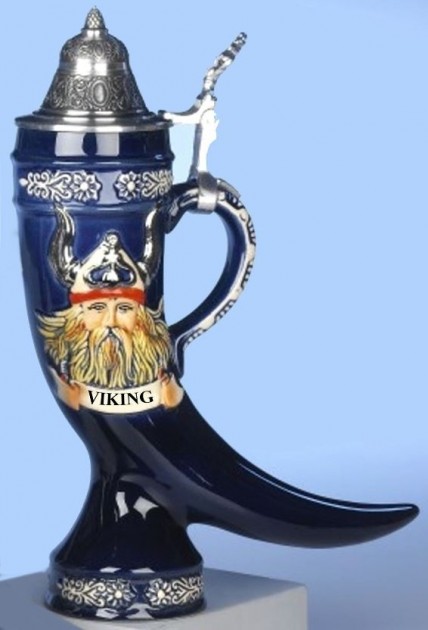
One liter pottery very new
.
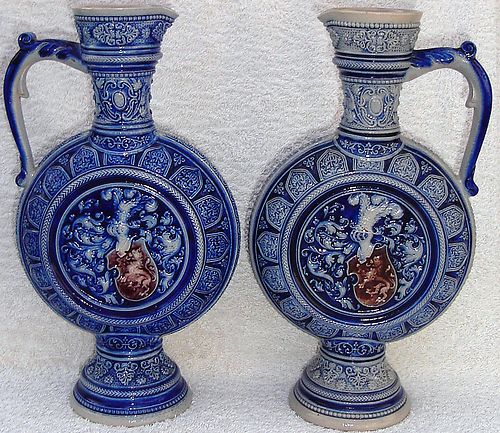
Drum wine jug – Another noted German name usage for what is now called in the USA, a ‘Moon Jug” or “Moon Flask.”
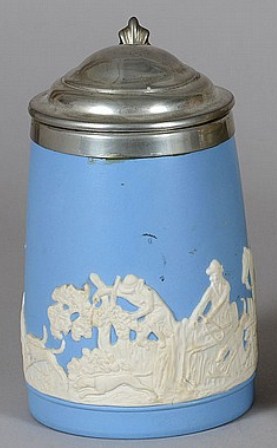
Dudson – James T. Dudson, Manufacturer of Earthenware, White and Colored Stone Bodies and Jasper Ware. Hope Street, Hanley. Shown: English jasper ware stein, height 6 1/4 In.
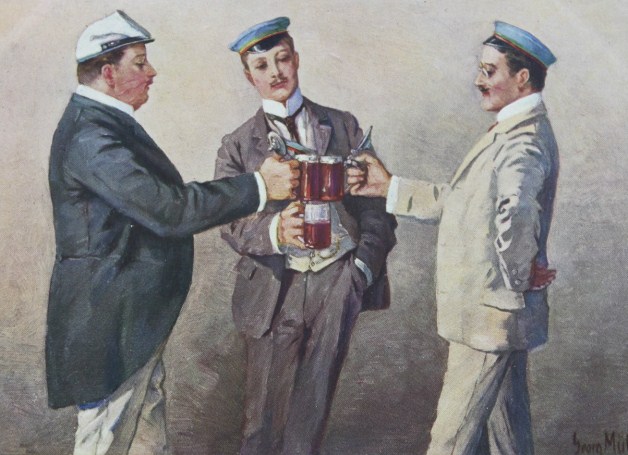
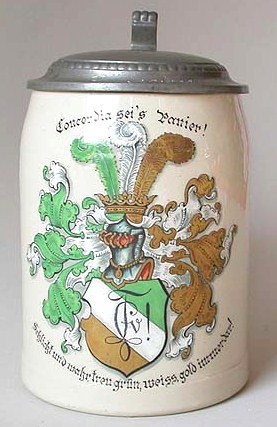
Concordia Corps Coburg Studentenkrug .
Dueling Sicieties / Student Societies) steins – There is no sense in me writing all about this subject when there is such a good introductory article on them already: See article:German Student Societies, History and Traditions, A Bibliography by Walter B. Vogdes @ the “Reading Room,” http://www.steincollectors.org/ From Vogdes article referenced above.: The origins of the German student societies stretch back to the 12th century, when the first European universities were formed in Bologna and Paris. Young men who spoke the same language and perhaps shared some family ties found protection by banding together. The first “German” university was founded in Prague in 1348, and it included four student organizations, at that time called Nationes. Still reflecting ties to a shared homeland, these groups were named for Bohemia, Bavaria, Saxony and Poland. Since those early days the societies have diversified quite a bit, but they still cling to centuries of tradition and ritual.
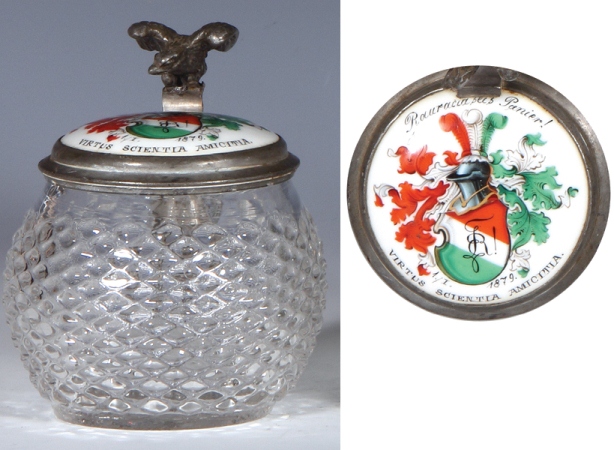
Shown above: 25L, mold blown, hobnail pattern, porcelain inlaid lid. “Rauracia sei’s Panier!” 1893 – 1894. [tsaco] Also see: [1] http://www.beerstein.net/articles/bsj-3a.htm [2] http://www.beerstein.net/articles/bsj-5b.htm STEVE’S NOTE: Many uneducated dealer s/ sellers on for sale web sites, now think that any stein that shows a brightly painted Coat of Arms is automatically a “Students stein., and they try to sell them as s=that. A couple Examples are below. There were other societies that had their arms on steins , notably Singing and Musical groups. 95% of All Student dueling Sovietizes will have arms where [1] one quarter will show crossed swords on it . [2] a Zirkel is displayed as on the glass stein just above.
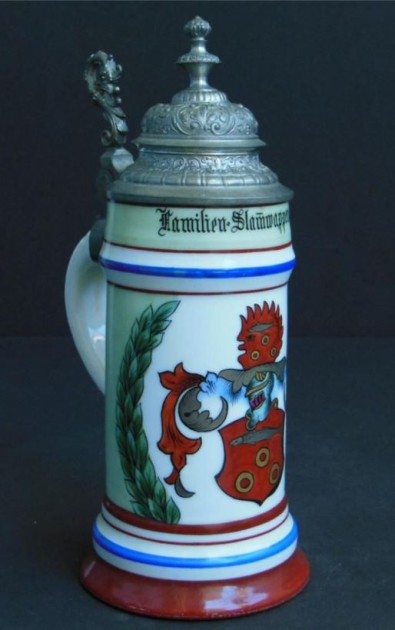
Was on eBay for sale advertised as a student stein . This is most probably a city’s Arms . With the city’s name on the top of body . –
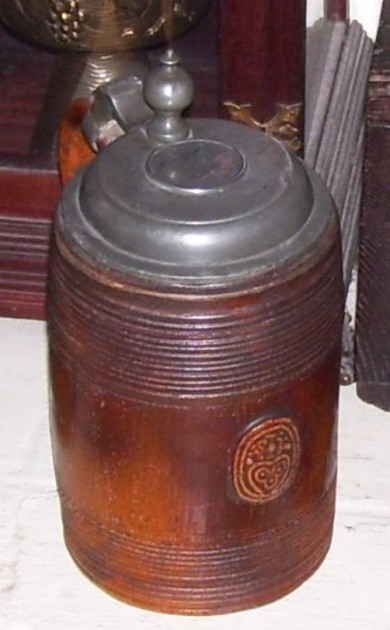
Duingen- German city famous for its brown stoneware steins which are often confused with those from Raeren. Shown ▲: A 1 liter Duingen with small “Arms” in relief on the front. – late 1600’s. The pewter lid with Ruler’s medallion added in Sweden in the mid 1800’s [FWTD]
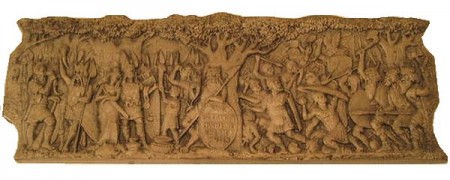
Dümler, Peter – The partner in Dummler & Breiden – Artist responsible for the original 1883 Ceramic Relief frieze of Arminius / Hermann. This featured Battle of the Teutoburg Forest relief scene was one of the first designs that he created for his own company Duemler & Breiden and was used also later by the companies Marzi & Remy and S.P. Gerz. For more on Hermann, see: http://www.steveonsteins.com/hermanns-story For D &B info see: http://www.steinmarks.co.uk/pages/pv.asp?p=stein1
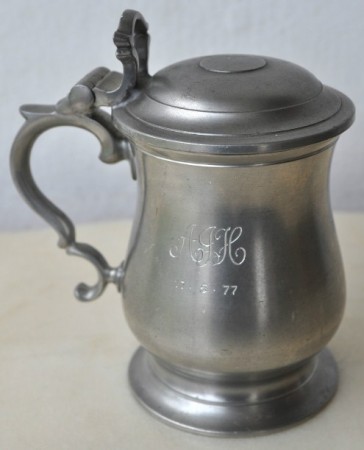
Dunhill, English – Maker of new pewter tankards in the 1800’s style as shown above.
“Durer” artwork – A series of different drinking vessels made in pewter by WMF in the late 1900’s. This series produced a stein, server, beaker and flask all with essentially the same Durer drawings, done in molded relief.
Durerturm – The tower on the Old City wall of Nuremberg that is closest to Durer’s home.
. 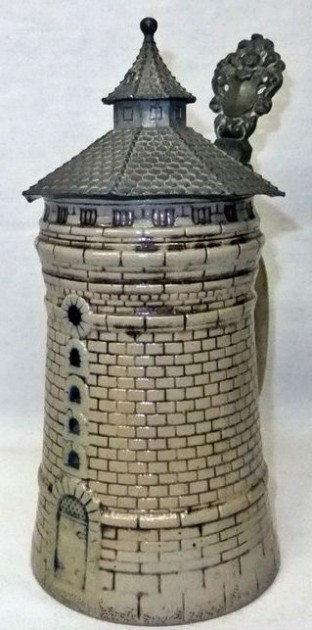
Durerturm is what this tower character stein is sometimes called, but I believe the stein is really modeled after another of the “old city’s” towers; the Sinwellturm (Sinwell Tower) at the Kaiserburg (Emperor’s castle.) Stein is marked “TW.”
Durlach, 1723-1812 – City or town of major fayence stein production. For more info, see: http://www.thepatriotexchange.com/pss/hisfai.htm
CR- DUTCH MAN AND WOMAN on-rocks-french-man-is-Jacquot-and-Jacqueline FWTD CALLED ORIENTAL BY FOX 2015
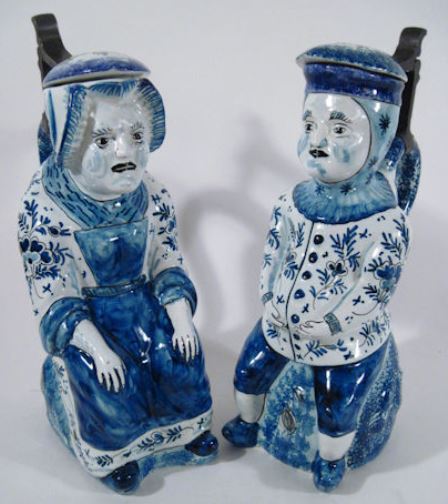

“Drink coffee! Do stupid things faster with more energy!”
[END – SOK? – 62- R5]
WISH TO CONTACT ME ABOUT SOMETHING ON THIS SITE ?

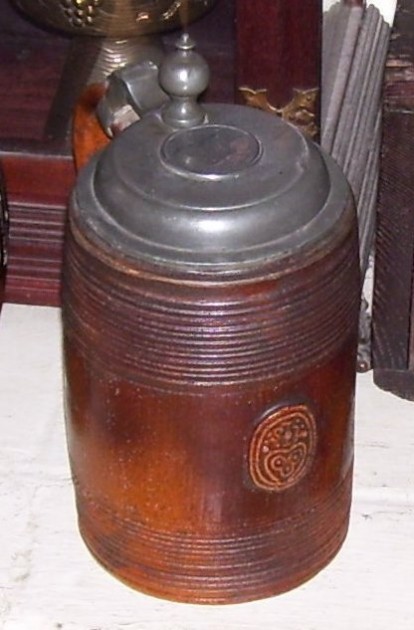
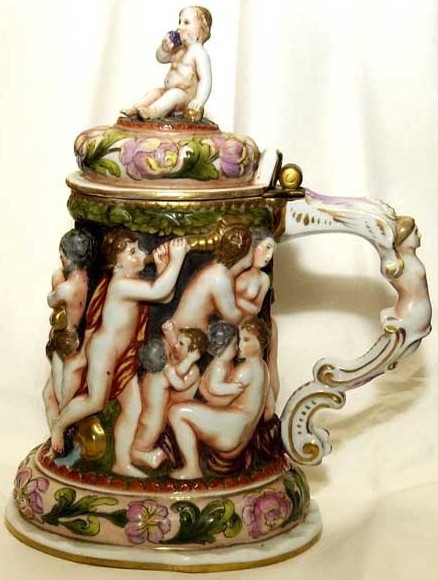
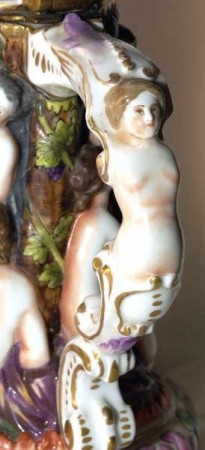
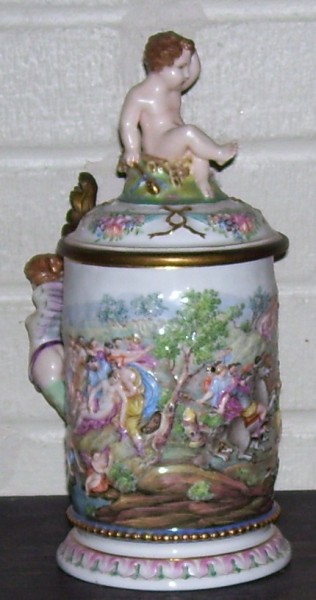
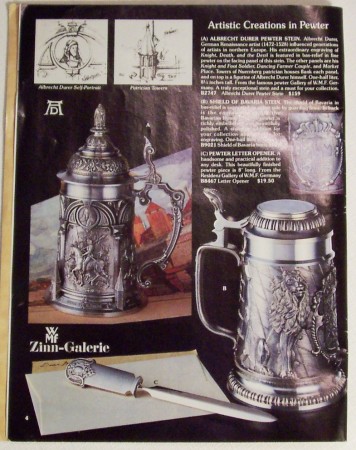
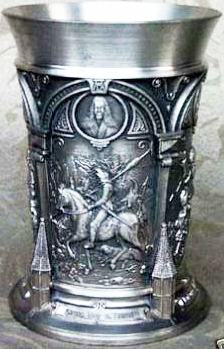
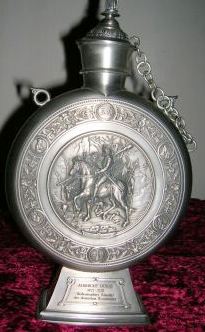
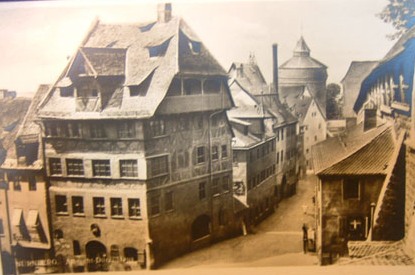
Leave a Reply